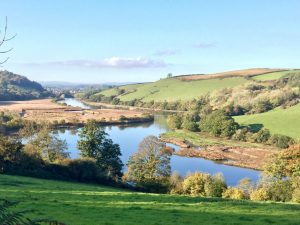Dartmoor: The Naming of our Famous National Park
The moorland in the south of Devon covers nearly 1,000 square miles. As well as being a wild and wonderful national park, it’s also the catchment area for many Devonshire rivers. The river Dart, one of the largest rivers gives this moorland its name – Dartmoor.
Dartmoor is made up of many smaller moors. All of these came under the name ‘Dartmoor’ in 1951 when the 368 square miles of land were designated a national park.
The Rivers that gave Dartmoor its name
The river Dart starts as two separate rivers. You’ll find the West Dart River head just south of Cut Hill and north of Rough Tor in the centre of Dartmoor. This flows south to Dartmeet where the East Dart River joins its flow. The East Dart River begins to the northwest of Postbridge hamlet and Whitehorse Hill.

After joining at Dartmeet, the East and West rivers become the Dart. From there it flows through Buckfastleigh where it leaves the moorland behind. After leaving the moor, The Dart passes through Totnes and joins the waters of the English Channel at Dartmouth.
Dartmoor: home to many rivers
The Dart River gave its name to Dartmoor, but the area is crisscrossed by 24 different rivers. The rivers Erme, Plym, Avon, Meavy, Tavy, Walkham, Okement, Lyd, Taw, Teign and Bovey are some of the larger waterways that run through Dartmoor National Park. Combined, these rivers cover 137 miles.
For centuries these waterways have been used for many different reasons. Along with being sources of drinking water, Dartmoor’s rivers have powered mines, generated electricity, moved goods and been ideal places for a spot of fishing or swimming.
Life-giving water from Dartmoor
The River Meavy was the first to be used as a source of drinking water for people in the city. In 1591, the construction of Drake’s Leat was completed to let water flow from the River Meavy all the way to Plymouth. Thanks to the success of this venture, the Devonport Leat was built using waters from the West Dart to quench the thirst of Devonport’s residents.
It’s not just the towns and cities that benefit from Dartmoor’s many rivers. These waterways create the special habitat needed for some of the area’s unusual species.
Salmon and sea trout migrate up Dartmoor’s rivers in the cooler months of November to January. A trip to Dartmoor at this time of year may reward lucky visitors with the spectacular view of sea trout and salmon runs heading for the clean gravels of their early lives.
Otters, dippers and wagtails, kingfishers and goosanders are just some of the other special creatures you can expect to find around Dartmoor’s waterways. These animals and the unique landscape of Dartmoor are some of the reasons this place has been treasured by tourists and locals for so many years.